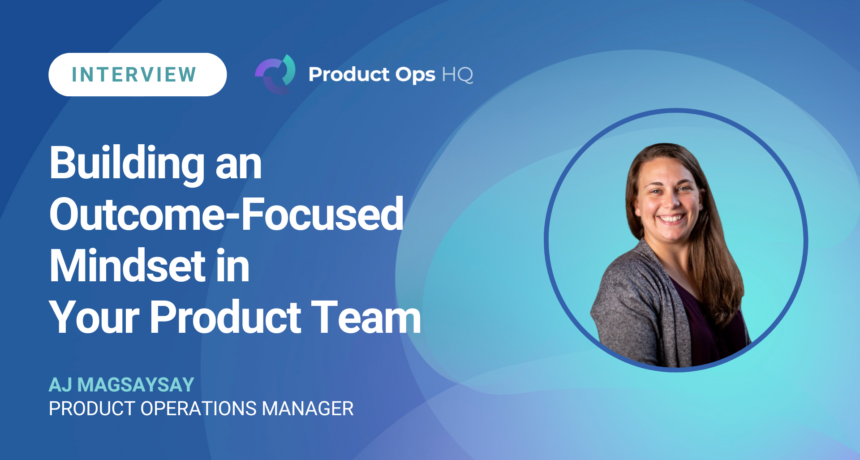This blog post was created in partnership with the Product Ops HQ community, the fastest-growing community where product operations professionals gather to connect, share knowledge, and learn.
Product Operations is gaining importance in businesses, and its benefits are being discovered. In this interview series, we dive into best practices from Product Operations Leaders and Responsive Product Portfolio (RPPM) advocates. RPPM is a framework that helps product-led organizations compete better, connecting goals, customer needs, products, and resources for faster value delivery and increased product returns. Join us to learn valuable insights and tips for success in Product Operations.
Interview with AJ Magsaysay
Welcome to our exclusive interview featuring AJ Magsaysay, a rising star in the Product Operations world. As a Product Operations Manager at Brightpearl, a prominent Retail Operations System, AJ brings a fresh perspective to the field of Product Operations, transitioning from a Corporate Operations role and leveraging previous experience in Project Management. With a background working closely with Product Managers and Engineers, AJ has quickly found her footing in Product Ops, making significant contributions to the success of the team.
Join us as we delve into AJ’s journey and insights in this exciting interview.
What was your role before you became a Product Operations professional? How long have you been in the Product Ops role?
Before Product Operations, I worked as a Corporate Operations Project Manager and before that as an Implementation Project Manager for our product. I have been in Product Operations since October 2022.
What are the biggest challenges facing your product teams?
One of the main challenges our Product Team faces is cross-team dependencies, in a few different ways. For example, being dependent on customer-facing teams for information, but being limited in how to push for those teams to provide it. We try to maintain a cooperative and helpful relationship with these teams, as it makes the process a lot easier. They understand we are working to better the product and need customer insights, so even if it doesn’t help in the immediate term, it will be beneficial for them overall. Without that goodwill, Product can miss out on critical insights.
Additionally, within Product, if one team needs something from another, it can be challenging to prioritize the work appropriately within the other teams’ backlog. This requires a lot of conversation and collaboration otherwise, you’d end up with teams being disgruntled with each other. We have dependency meetings and transparent conversations in order to combat challenges here.
How does your team/management measure your success as Product Ops?
My success in Product Ops is measured by the outcomes of the projects I work on. We use OKRs so for major initiatives we agree on Objectives and Key Results which we then review throughout the quarter and after a project is complete.
Learn more about OKR templates for Product Operations here.
In your experience, how can Product Ops help establish an outcome-focused practice?
There are ways this can be built into processes, certainly. For example, when a new initiative/project is being raised, create a step in the process to document outcomes and requirements.
However, being outcome focused is also a mentality to curate within the team. Think of situations that arise outside of standard processes, this is fairly typical at my company. I find simply being there to ask the question “What are trying to accomplish?” helps to nudge the conversations into outcome-focused discussions. Doing that for a bit can build good habits and get the team thinking about outcomes and asking the right questions even if Product Ops isn’t in the meeting.
Learn more about The Role of Product Operations – Enabling an Outcome Focused Product Organization here.
Other than product and engineering teams, what other groups (in the company and externally) do you work closely with?
I work closely with our customer-facing teams, specifically our Customer Success and Support teams. These relationships help Product Operations because these voices are important when understanding how customers interact with our business, what their needs and concerns are, and help identify pain points we may need to address. The Customer-facing teams raise these to Product, who can then evaluate the feedback and determine if something is valuable or priority enough to add to the backlog. Product Operations supports this process and helps ensure communication runs smoothly and Product has a way to evaluate the feedback.
Another benefit I have found from feedback from Customer Facing teams is celebrating our wins within Product. It can be easy to gloss over small changes as less impactful than major features and releases, but they do impact our customers. It’s nice to get feedback from Customer Success that someone really benefited from some small change. We have a Slack channel for fab-feedback and it is a great way to brighten the day.
Keeping up with industry trends and changes in customer needs is a never-ending task, what methods do you use to stay informed? Is there a particular source (website, book, podcast, expert…) you recommend?
Product Ops HQ is a great resource, specifically the Slack community and the virtual meetups.
In addition to this, I am an avid listener to Melissa Perri’s podcast, Product Thinking.
We hope you found this interview with AJ Magsaysay informative and insightful. Want to learn more? Connect with her on Linkedin.
Are you seeking to elevate your organization’s Product Operations to the next level? Dragonboat, the industry-leading platform for product portfolio management, can help you get there. Streamline processes, drive better outcomes, and stay ahead of the competition. Seamlessly connect your OKRs, customer insights, and product initiatives in one centralized source of truth. Book a demo today and see how Dragonboat can help take your organization’s success to the next level.



